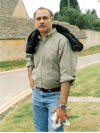|
|
the-south-asian.com July / August 2006 |
|
|||
|
August/September Contents
Sufis - wisdom against 50
years of mountain Heritage cities:
Cotton - the fibre of
|
|
||||
|
Page 2 of
3 Sufis - Wisdom against Violence (cntd.) by Salman Minhas
First published April 2001
South Asia - a brief history of human evolution The first act of this drama is from the early civilizations of Mohenjodaro and Harappa 3000-5000 BC - where potter’s wheel, and bow drill were first invented. Sindhi Dravidic language evolved from originally Dravidian terms and phonetics to Aryan Prakritic languages resulting from Aryan invasions from west of South Asia. The Vedic writings and the Mauryan, Buddhist, Gandhara texts followed this as the second act. Yet, during the saga of continuing invasions of Alexander the Greek [326-325 BC], the Ghaznavids, followed by Central Asians -Timurlane, Babar, Nadir Shah - there have been a few messengers and saints in the name of Sufis who came and settled amidst the same ancient civilizations - that of the Indus valley of Sind and Punjab- and beyond in Delhi, Ajmer and Kashmir. Central Asian & Mongolian tribes [Ghengis Khan’s descendents, namely Timur the Lame] were constantly raiding, invading and pillaging parts of Northern India. Delhi and Lahore were the usual targets, with Lahore receiving a " double whammy" as Punjab was like a "half-way" house both on the way and going back towards central Asia. Eminent scholars and administrators migrated to Lahore and Delhi from Central Asia. Prosperity [Surplus value] and the evolution of Language: The prosperity of this area gave rise to a settled civilization "Indus valley " .The languages of Sindh and Punjab were originally influenced by the old Dravidian phonetics and words and later by Aryan [Sanskrit, Prakritic]. Later Persian and Arabic scripts and words were used. Sir Bartle Frere the Commissioner of Sindh, under the initiative of Sir Richard Burton, an orientalist, and with the help of local scholars Munshi Thanwardas and Mirza Sadiq Ali Baig, evolved a 52 - letter Sindhi alphabet that is still in vogue today. Punjabi never became the official language in Punjab even in the days of Ranjit Singh. Sikh scholars did all their work in Persian. The last twenty years of Sikh rule [called Sikha Shahi] after Ranjit Singh saw anarchy let loose in Punjab. It prompted Ranjit Singh’s wife "Rani Jindan", after seeing their ruling family killed, to invite the British to take over. The majority of the people of Punjab welcomed the British; such was the shattered social condition. These events led the Punjabi poets to write about the anarchy, rebellion, and other issues [mocking clergy] in their verses. [The Punjab was later to become the chief source of soldier stock [cannon fodder] who fought under the British Armies in the Second World War. There are villages in Chakwal that have the highest number of Victoria Crosses. Apart from Buddha and other great spiritual leaders of the south Asian diaspora, there have been some Sufi saints and poets whose writings are alive with the themes of love, peace, reflection, generosity and faith in simple peasant metaphors. Today common people flock to the shrines of these Sufi Mystics - Baba Farid Shakar Ganj of Pakpattan, Bulleh Shah at Kasur, Khwaja Nizamuddin in Delhi, Moinuddin Chishti at Ajmer, Saleem Chishti at Fatehpur Sikri, Sachal Sarmast in Daraaz, Khairpur in Sindh, Shah Abdul Lateef Bhitai in Sindh. Their Kafis, Dohras have been kept alive in the hearts and souls of the common south Asian people both in cities and in villages. The songs by many a village singer, minstrel at the shrines of these saints and by some of the contemporary singers such as Late Nusrat Fateh Ali Khan, Reshma, Junoon group, Abida Parveen, Jiji Zarina Baloch in Pakistan and Wajdali brothers in India have preserved, extended and mass promoted the messages of some of these South Asian Saints /Sufis and Poets in popular form. What follows below are small essays & quotes from some of these Sufi Poets and mystics from the South Asian lands. They do not discuss annihilation or division between peoples. Their talk is of life after death, and the liberation of the soul and how to live in the present, following the rhythms and cycles of birth, love, rebellion, growth, nurture, maturity and human evolution. Because they lived amidst great social upheaval and unrest, especially later during the fall of the Mughal Empire, their writings questioned and rebelled against the established institutions of the maulvi [priest/clergy] and social norms. The Lahore [left bank of Ravi] Sufi Intellectuals The decline of the Ghaznavids and the rise of the Ghurids in the Lahore region led many scholars to migrate there. Among the notable leading intellects & scholars, famous for their translation of works from Arabic, Persian and Hindi / Sanskrit were: 1. Sheikh Ali Hujweri -[AD 1074] also known as Hazrat Data Ganj Baksh came from Ghazni, wrote a famous book "Kashf-ul-Mahjub" - still published. His shrine is alive with worshippers who come to lay flower wreaths on his grave; near the old city [Bhatti Gate] Lahore, half a mile west of Government College. 2. Masud Saad Salman- [AD 1121] wrote 3 Diwans in Arabic, Persian, Hindi according to Amir Khusro, the famous musical composer. 3. Abu Raihan Albaruni [AD 973-1048] - taught Greek [Unani] Science, and studied Hindu achievements and wrote a magnus opus " Kitab-al Hind". 4. Abul Farj Runi -a poet, born and educated in Lahore [Runi is a village near Lahore]. 5. Sultan Sakhi Sarwar an eminent saint; a Hindu tribe in Punjab is known after his name Sultan.
|
|||||
|
Copyright © 2000 - 2006 [the-south-asian.com]. Intellectual Property. All rights reserved. |
|||||
